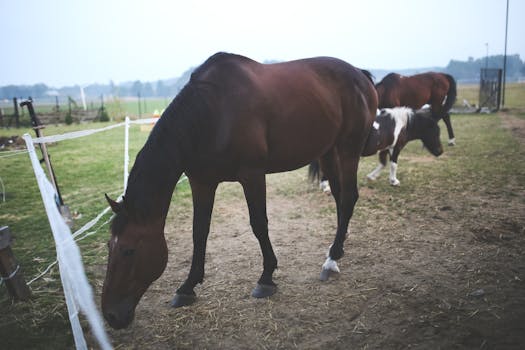Botflies are a major source of irritation for both horse and owner during the warm, summer months. You may have seen the tiny eggs on your horses’ legs from bots. It is critical to remove the eggs, so the horse does not ingest the bot fly eggs and have them hatch. [social_warfare buttons=”Facebook,Pinterest,Twitter,Total”]
 So what exactly are botflies?
So what exactly are botflies?
Botflies are just that – flies that irritate the horse. They do not actually cause any pain by stinging or biting the horse, they simply lay their eggs and depart. Their appearance has been compared to that of a skinny bee. They have a light yellowish coloring and a thinner body than that of a bee.
Botflies lay their eggs on the horse. You may have seen eggs on your horse’s legs which need to be removed immediately. These flies like to lay their eggs on horse’s legs, around their face, nose, or muzzle, and also on the horse’s belly.
There are three known types of botflies that can affect your horse:
The Common Horse Bot lays eggs on general areas on the horse’s body.
The Nose Bot lays eggs around the horses’ nose and face. This type of bot is not very common.
The Throat Bot lays eggs near the horse’s throat or on the chin and undercarriage of the horse’s face.
What do These Eggs Look Like?

Bot eggs can be a few different variations of colors. Usually, they appear in a cream, yellowish or orangish colors in clusters on a horse’s legs, face, or belly. They usually stand out on any color horse due to their off-coloring.
How do Bots Work?
Bots lay their eggs in hopes that the horse will ingest them. The main goal of the botfly is to have their larvae reach the horse’s stomach. Horses can ingest bots by grooming each other, biting the area on their legs or belly that have bot fly eggs, or licking the area and ingesting the eggs.
Once that happens, botfly eggs hatch into larvae and live in the horse’s mouth for approximately four weeks before making their way into the digestive system and ultimately the stomach. The bots attach to the horse’s gastric lining of the stomach, and can live there for up to 10 months. They are then released through the horse’s feces and burrow into the ground as they reach the final stage of maturity and then the entire cycle repeats itself.
They are mostly a seasonal irritation, and the cycle begins again as the adult s emerge from the ground.
Bots thrive in warm temperatures and are commonly seen on the summer months. States such as Florida that have warm, humid temperatures year-round have seen active Bots throughout the entire year.
Are There Symptoms Your Horse May Have Bots?
Bot larvae can be irritating to a horse if they are ingested. Some common warning signs that your horse may be affected by bots are:
Ulcers that have appeared around the horses’ nose or mouth
Rubbing of the face and lips to relieve the irritation.
Colic symptoms and colic – Botfly eggs that are ingested have been known to cause colic due to blockage or ulcers. Watch for signs of stomach pain in your horse such as constant rolling or biting at the sides of the stomach.
Dental problems/issues – Bot fly larvae reside on your horses’ mouth for almost a month before moving to the digestive system. They can cause severe gum irritation and even loose teeth.
Loss of weight – Bot larvae attach to the horse’s gastric lining. Your horse may lose weight, have a hard time keeping weight on, or may have a loss of appetite.
What Can You Do?
As horse owners, there are some steps you can take to reduce the likelihood of a bot infestation. Regular and reoccurring use of fly spray can repel botflies. Spraying the horse before turnout and in their stalls can repel flies and other insects. The use of fly sheets or fly leg wraps can also help.
Having a good manure management plan in place is also crucial. Keeping the manure pile away from the barn can also help keep flies and other insects away from the areas where the horses live.
Deworming on a regular schedule can also help get rid of botfly eggs that may have been ingested. Examination if your horse’s manure can show evidence of botflies, especially if the horse is heavily infested. Do not wait until botflies appear in the manure. Prevention is the best medicine for botflies and botfly eggs.
Removal of the botfly eggs is also a crucial step. A Bot Egg Knife is used to scrape off the eggs. It is a common, useful tool many horse owners either have or aware of. It is a blunt knife and will not harm you or your horse if used properly. Simply slide the dull blade along the horse’s legs and the eggs will scrape off.

Daily inspection of your horses’ legs, belly, and face can help reduce the number of eggs as well. This can help reduce the number of eggs and the reduce the chance of your horse ingesting them. Know that botfly season is in the warmer months and prepare by using fly spray and observing your horse’s behavior as well as performing daily inspections of their legs, face and belly in search for eggs.